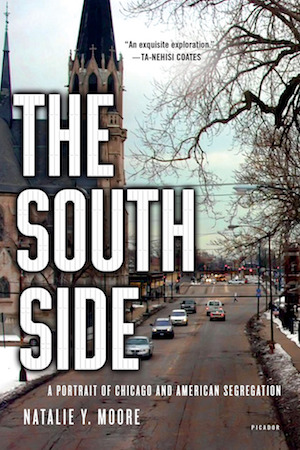 I’m pleased and honored to have a new book review published on Escape Into Life, this one looking at Chicago reporter Natalie Moore’s 2016 book The South Side. I finished this book back on Martin Luther King Day, which seemed fitting, and I mentioned it briefly in this space at the time. The new piece on EIL is more complete—and also written mostly in complete sentences, so I’m right proud of myself.
I’m pleased and honored to have a new book review published on Escape Into Life, this one looking at Chicago reporter Natalie Moore’s 2016 book The South Side. I finished this book back on Martin Luther King Day, which seemed fitting, and I mentioned it briefly in this space at the time. The new piece on EIL is more complete—and also written mostly in complete sentences, so I’m right proud of myself.
One suggestion I make in the review is that The South Side would be a great book to read with a discussion group. It’s chockfull of thought-provoking interviews, data and personal stories, and raises a lot of serious issues that deserve discussion. I actually wrote down a few questions to ponder as I was reading it, and I offer those up here for anyone who interested in fueling a discussion. Bring these questions along with your own to your book group’s meeting—or, if you’re not reading The South Side with a book group, offer your answers for discussion here.
- The South Side approaches segregation primarily in terms of race, but it is intertwined with issues of class and economics. Which, if any, is the most important factor if the goal is to improve the lives and status of blacks? Do you think blacks and nonblacks would answer that question the same way?
- Moore takes issue with the term Chiraq, mentioning numerous rappers who have used it, as well as filmmaker Spike Lee. Does her criticism of it include criticism of the artists who have made use of it? If so, do you think that criticism is warranted?
- The chapter “Searching for Harold” focuses attention on the inability of blacks to recapture the mayor’s office since the death of Harold Washington, asking: “Will there be another Harold Washington? Or at least another black mayor in Chicago?” Is that the right focus if the goal is to improve status and living conditions for black Chicagoans?
- In the last chapter, Northwestern University professor Mary Pattillo is quoted as saying. “Is ending segregation first the right approach, or is improving predominantly black neighborhoods as predominantly black neighborhoods — should that be our first goal, and might that result in more racial integration because it would make those neighborhoods more appealing for nonblacks to move into?” How would you answer that question?
- The book is a combination of reporting, research and personal history. Does it strike a good balance? Would you have liked to see more or less of one of these?
By the way, The South Side is just 225 pages in paperback (the volume shown here) and a really quick read. That increases the odds that people will actually read it before the meeting, making it an even better book club selection. Big shout-out here to my book club, which chooses titles with that consideration front of mind.
Happy reading!
